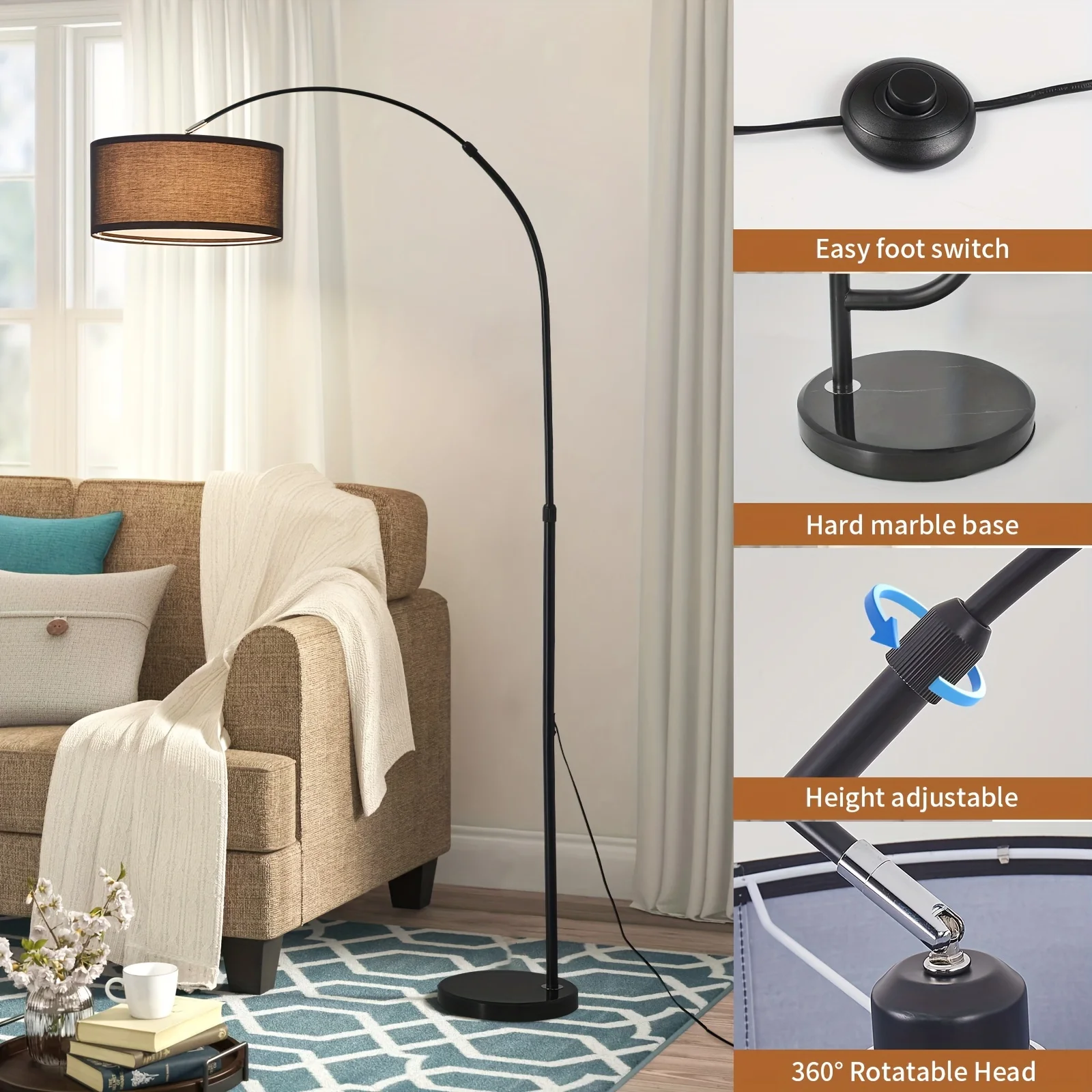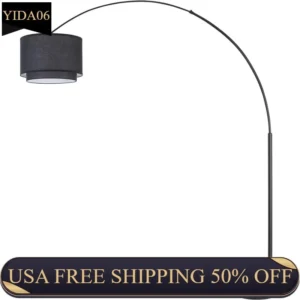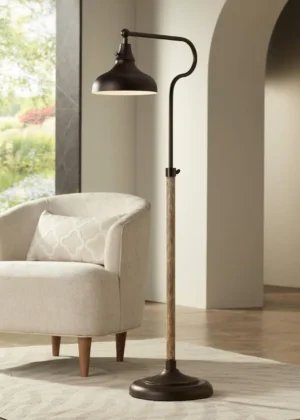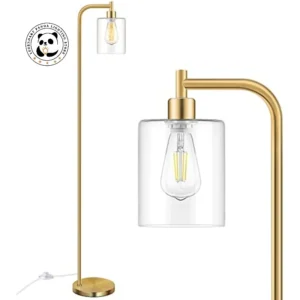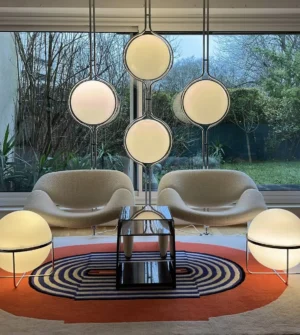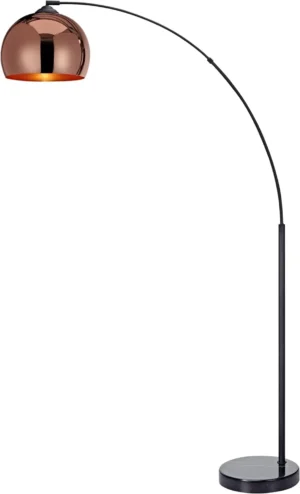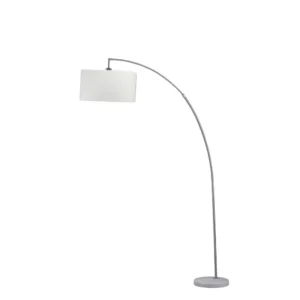Introduction: Understanding Why Tall Floor Lamps Need Securing
Tall floor lamps add elegance and functional lighting to our homes, but their design often creates inherent stability challenges. These beautiful lighting fixtures frequently suffer from:
- Top-heavy designs with narrow bases creating an unbalanced weight distribution
- High centers of gravity making them prone to tipping over
- Long, sometimes flexible poles that can wobble or lean over time
When these lamps fall, they pose serious risks beyond just breaking the lamp itself. They can cause injuries to family members or pets, damage other furniture, and in worst-case scenarios, even create fire hazards from damaged electrical components.
Rather than waiting for an accident to happen, taking preventative measures is both safer and more cost-effective. Throughout this guide, we’ll explore comprehensive solutions for securing your tall floor lamps, from simple base modifications to wall anchoring techniques. Proper lamp stability not only enhances safety but also preserves the aesthetic integrity of these statement pieces in your home decor. Understanding the ultimate guide to arc floor lamp base provides an excellent foundation for addressing these stability issues.
Understanding the Risks of Unstable Tall Floor Lamps
Unstable tall floor lamps create several significant risks that shouldn’t be overlooked in any home setting:
Physical Safety Hazards
Tall floor lamps can weigh 10-30 pounds or more, with metal components and glass shades that may shatter upon impact. Children and pets are particularly vulnerable, as they might pull on cords or bump into lamp poles during play. Adults can also be injured when attempting to catch a falling lamp or by tripping over one that’s already fallen.
Property Damage Concerns
When a floor lamp tips over, it can damage not just the lamp itself but also nearby furniture, electronics, or decorative items. Hardwood floors may get scratched or dented from the impact of heavy lamp bases.
Electrical Safety Issues
Perhaps most concerning are the electrical hazards. Falling lamps can damage wiring, creating short circuits or exposing live wires. This significantly increases fire risks and electrical shock hazards in your home.
Performance and Enjoyment
Even if a lamp doesn’t completely fall, constant wobbling affects light direction and creates distracting shadows. This unstable movement diminishes both the functional purpose and aesthetic appeal of your lighting.
Having stable, secure floor lamps provides genuine peace of mind, especially in busy households. Learning about preventing arc lamps tipping can help you address these risks before accidents occur.
How to Assess Your Lamp’s Current Stability
Before implementing solutions, you need to understand your lamp’s current stability level. Follow these simple assessment steps:
The Gentle Push Test
* Apply light pressure to the middle of the lamp pole
* Observe how much the lamp moves and whether it returns to its original position
* Note if the base lifts on one side during this test
Surface Contact Evaluation
* Check if the lamp base sits flat on the floor without rocking
* Look for gaps between the base and floor surface
* Examine if all feet or contact points are touching the ground evenly
Base and Height Assessment
* Measure the diameter of the base compared to the height (a good rule: base diameter should be at least 1/3 of the lamp’s height)
* Check the base weight—heavier bases generally provide better stability
* Assess if the weight feels concentrated in the base or distributed higher up
Hardware and Connection Inspection
* Examine all connecting points, poles, and hardware for looseness
* Tighten any loose screws or connections
* Check if poles are perfectly straight or showing signs of bending
Environmental Considerations
* Evaluate the floor type (carpet, hardwood, tile) where the lamp sits
* Consider room traffic patterns around the lamp
* Note proximity to doors, windows, or air vents that might cause movement
These assessments will help you determine which securing methods will be most effective. For a more comprehensive approach, explore our stabilize floor lamp base complete guide for detailed solutions.
Essential Methods for Securing Top-Heavy Floor Lamps
Adding Weight to the Base for Better Balance
Adding weight to your lamp base is one of the simplest and most effective stability solutions. This works by lowering the center of gravity, making the lamp more resistant to tipping.
Understanding Center of Gravity
The stability of any floor lamp depends on where most of its weight is concentrated. Top-heavy lamps with lightweight bases are naturally prone to tipping. By adding weight to the base, you shift the center of gravity lower, dramatically improving stability.
Commercial Weighting Solutions:
* Purpose-made lamp weights (circular discs designed to fit under lamp bases)
* Weighted filling materials specifically for hollow lamp bases
* Adhesive weights that can be attached to the underside of the base
DIY Weighting Options:
* Sand bags (1-5 pounds) that can be placed on or inside the base
* Small bags of aquarium gravel for flexible placement
* Flat metal plates secured to the bottom of the base
Implementation Steps:
1. Determine if your lamp base is hollow or solid
2. For hollow bases, remove any plugs or covers to access the interior
3. Add weight material (sand, gravel, weights) inside the base
4. For solid bases, add flat weights underneath or around the exterior
5. Ensure weight is evenly distributed for balanced stability
For lamps taller than 5 feet, consider adding 3-5 pounds of weight; for lamps over 6 feet, 5-8 pounds may be necessary for proper stability. Exploring weighted bases for arc lamps can provide specific techniques tailored to these elegant but often unstable lighting fixtures.
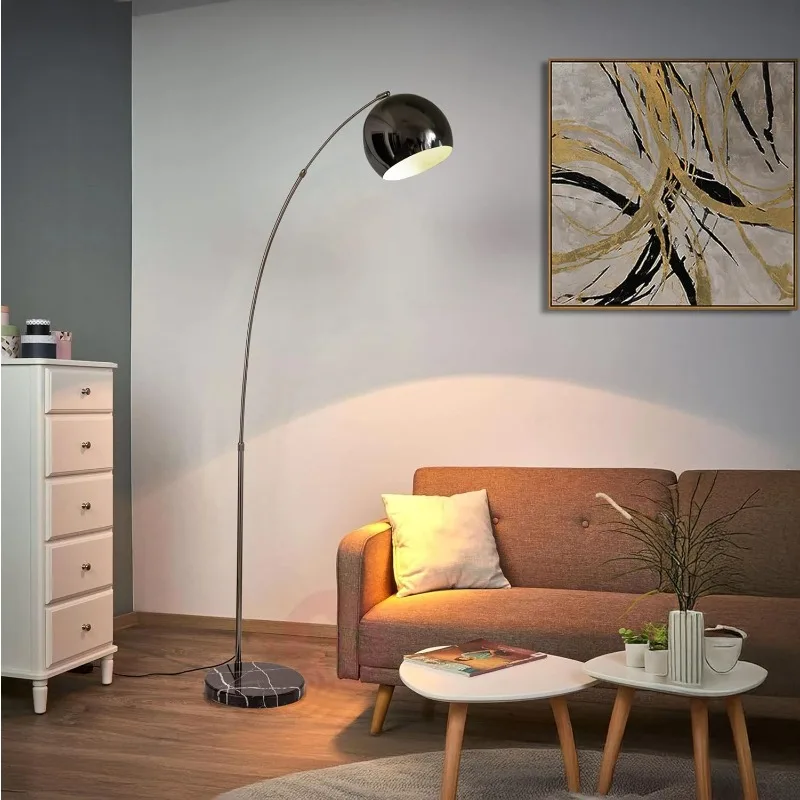
Anchoring Lamps to Walls and Furniture
When adding weight isn’t enough, anchoring your lamp to nearby structures provides excellent stability, especially for exceptionally tall or top-heavy designs.
Anchoring Options:
* Furniture straps (similar to baby-proofing straps)
* L-brackets for secure wall mounting
* Safety anchors with adhesive or screw attachments
* Clear nylon cord systems for discreet securing
Materials You’ll Need:
* Appropriate anchoring hardware for your wall type
* Screwdriver or drill with correct bits
* Level to ensure straight installation
* Measuring tape
* Pencil for marking installation points
Wall Anchoring Steps:
1. Position your lamp where you want it to stand
2. Measure the height where the anchor will attach to the lamp pole
3. Mark the corresponding point on the wall
4. Install the wall anchor using appropriate hardware for your wall type
5. Attach the securing strap or cable between the lamp and wall anchor
6. Adjust tension to allow minimal movement while maintaining stability
Furniture-Based Anchoring:
1. Identify a heavy, stable piece of furniture near your lamp
2. Secure one end of a furniture strap to the lamp pole
3. Attach the other end to the furniture piece
4. Ensure the strap is tight enough to prevent tipping but not pulling the lamp
These anchoring methods work particularly well with large oversized arc floor lamps where base weight alone may not provide adequate stability due to their extended reach.
Non-Slip Base Solutions for Different Floor Types
Even properly weighted lamps can slide on slippery surfaces, creating instability. Non-slip solutions address horizontal movement while preserving your lamp’s appearance.
| Floor Type | Recommended Non-Slip Solutions | Features |
|---|---|---|
| Hardwood/Laminate | Silicone non-slip pads, Rubber furniture grippers | Won’t damage finish, Nearly invisible |
| Tile/Stone | Heavy-duty rubber mats, Cork pads | Strong grip, Moisture resistant |
| Carpet | Carpet-to-carpet tape, Non-slip carpet pads | Prevents sinking, Adds friction |
| Vinyl/Linoleum | Felt pads with rubber backing, Non-skid silicone dots | Gentle on soft surfaces, Strong hold |
Commercial Non-Slip Products:
* Furniture grippers designed specifically for preventing movement
* Silicone or rubber mats cut to fit your lamp base
* Non-slip discs that blend with your lamp design
DIY Non-Slip Solutions:
* Cut pieces of non-slip shelf liner to fit under the base
* Apply silicone caulk dots to the base underside (allowing to dry before placement)
* Create custom non-slip pads from cork or rubber materials
For maximum effectiveness, ensure the entire base contact surface is covered with the non-slip material. Clean both the lamp base and floor surface thoroughly before application to remove dust or oils that could reduce friction.
Marble base arc floor lamps naturally provide excellent stability through their substantial weight, but can still benefit from non-slip solutions on particularly smooth floors.
Fixing Structural Issues in the Lamp Itself
Sometimes instability stems from problems within the lamp’s construction. Addressing these structural issues can significantly improve stability without additional accessories.
Common Structural Problems:
* Loose connections between pole sections
* Wobbly or misaligned base attachments
* Bent or damaged poles
* Stripped screws or loose hardware
Tools You’ll Need:
* Screwdriver set (both Phillips and flathead)
* Adjustable wrench
* Thread-locking compound (like blue Loctite)
* Replacement hardware if needed
* Level for alignment checks
Repair Techniques:
1. Tighten all visible screws, especially at the base and pole connections
2. Apply a small amount of thread-locking compound to screws that frequently loosen
3. Check if poles are perfectly straight using a level
4. Reinforce connection points with metal tape or brackets if needed
5. Replace any stripped screws with slightly larger alternatives
When to Replace vs. Repair:
* Minor looseness can typically be fixed with tightening
* Severely bent poles generally need replacement
* Cracked or broken bases should be replaced rather than repaired
* If connection points are stripped or damaged beyond repair, contact the manufacturer for replacement parts
For lamps that continue to lean despite these fixes, our guide on how to keep floor lamps from leaning provides additional specialized solutions.
Specialized Solutions for Different Environments
Securing Lamps on Carpeted Surfaces
Carpeted floors present unique challenges for lamp stability due to their uneven, soft surface.
Carpet-Specific Challenges:
* Bases sink unevenly into carpet pile
* Reduced friction compared to hard surfaces
* Carpet compression over time creating imbalance
* Thicker padding underneath allowing more movement
Effective Carpet Solutions:
* Rigid platform bases that distribute weight evenly across carpet
* Specialized carpet anchors that grip the fibers
* Carpet-to-carpet tape for increased friction
* Wider, heavier bases that resist sinking
Preventing Carpet Depression:
* Rotate the lamp position slightly every few weeks
* Use carpet protector mats underneath the base
* Choose lamps with wider feet or bases for better weight distribution
Adjustable arc floor lamps offer particular advantages on carpeted surfaces, as their height and angle flexibility allows for stability adjustments based on specific carpet conditions.
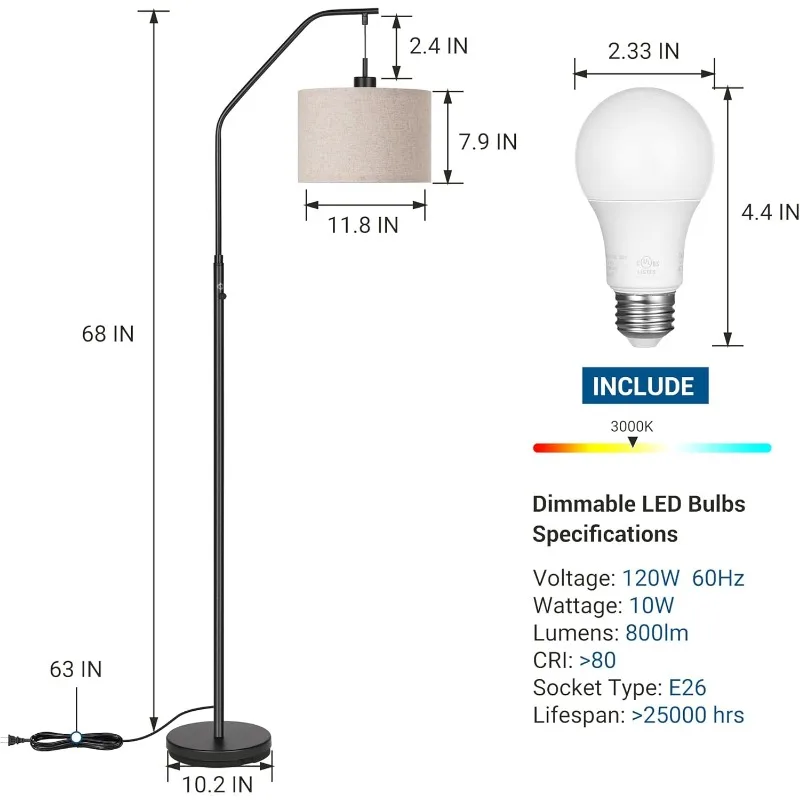
Stabilizing Lamps on Hard and Slippery Floors
Hard surfaces like hardwood, tile, or laminate create different stability challenges than carpet, primarily related to sliding rather than sinking.
Hard Surface Challenges:
* Minimal natural friction, especially on polished surfaces
* Potential for scratching or damaging floors from lamp movement
* Even small bumps can cause significant lamp movement
* Vibrations travel more easily through hard surfaces
Best Non-Slip Materials for Hard Floors:
* Silicone-based pads provide excellent grip without damaging finishes
* Rubber discs with furniture-safe backing prevent sliding
* Cork underlayment offers natural grip with floor protection
* Felt pads with rubber backing combine floor protection with stability
Combined Approaches:
* Use both weighted bases AND non-slip materials for maximum stability
* Consider both anchoring AND non-slip solutions for extremely tall lamps
* Layer different materials for custom friction levels
Floor Protection While Securing:
* Always use non-marking materials on finished floors
* Avoid adhesives that might damage floor finishes
* Choose acid-free materials that won’t discolor flooring over time
Dimmable arc floor lamps typically feature stable bases designed for various floor types, but can still benefit from these additional stabilizing techniques.
Child and Pet-Proofing Your Tall Floor Lamps
Homes with children or pets require extra consideration for lamp stability and safety.
Strategic Placement:
* Position lamps away from main traffic paths and play areas
* Place behind furniture when possible to block access
* Avoid placing lamps near climbing opportunities for children
* Keep lamps away from areas where pets frequently run or play
Enhanced Securing for Active Households:
* Use multiple securing methods simultaneously (weights + anchors)
* Consider temporary lamp removal during particularly active play times
* Choose lamps with wider, heavier bases when children are young
* Inspect security measures regularly as children grow and abilities change
Cord Management for Safety:
* Use cord covers or cord management systems to prevent pulling
* Secure excess cord length with cord shorteners
* Route cords away from walkways and behind furniture
* Consider cordless rechargeable lamps for maximum safety
Teaching Safety:
* Explain to children why lamps shouldn’t be touched or played with
* Demonstrate the “no touch” rule consistently with young children
* Create clear boundaries around lighting fixtures
* Praise children for respecting lamp safety rules
For homes with active pets or children, proper cord organization tips for arc lamps can significantly reduce the risk of lamps being pulled over.
Choosing the Right Securing Method for Your Specific Lamp
With so many options available, selecting the right stability approach depends on your specific lamp style and home environment.
For Arc Lamps vs. Straight Pole Lamps:
Arc lamps typically need more substantial securing due to their extended reach and offset center of gravity. Consider combination approaches like weighted bases with wall anchoring. Straight pole lamps often benefit most from base stabilization techniques.
Based on Lamp Dimensions:
* For lamps under 5 feet: Base weights and non-slip pads are often sufficient
* For lamps 5-6 feet: Consider base weights plus furniture anchoring
* For lamps over 6 feet: Multiple securing methods recommended, including wall anchoring
Aesthetic Considerations:
* For decorative statement lamps: Choose hidden securing methods like internal weights
* For minimalist designs: Select sleek, low-profile securing products
* For traditional styles: Disguise securing methods with decorative covers or strategic placement
Household Conditions Decision Framework:
* High-traffic areas require more robust securing methods
* Homes with children/pets benefit from multiple security approaches
* Rental properties need non-damaging solutions like furniture anchors instead of wall mounts
* Areas with air vents or fans need particularly secure installations
When evaluating floor lamps, understanding what to look for in an arc floor lamp helps identify models with better inherent stability features.
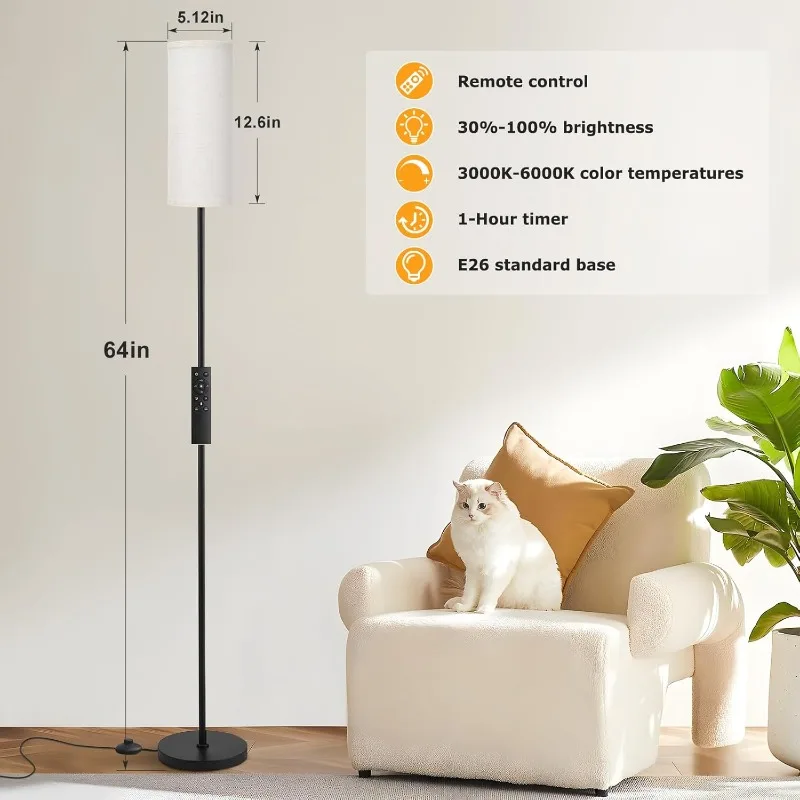
How to Maintain Lamp Stability Over Time
Securing your lamp isn’t a one-time task—ongoing maintenance ensures continued stability and safety.
Regular Stability Check Schedule:
* Weekly visual inspection of securing mechanisms
* Monthly physical stability test (gentle push test)
* Quarterly tightening of all connections and hardware
* Seasonal reassessment when changing home layouts
Warning Signs of Deteriorating Stability:
* Increased wobbling or movement
* Visible leaning that wasn’t present before
* Loosening of previously tight connections
* Degradation of non-slip materials or anchors
Maintenance Tasks:
* Clean non-slip pads to remove dust that reduces friction
* Replace worn or compressed materials under lamp bases
* Re-tighten all hardware connections regularly
* Inspect cords for damage or wear that might affect stability
Post-Movement Adjustments:
* After cleaning under or around lamps
* Following furniture rearrangement
* After seasonal decor changes
* When moving lamps to new locations
Popular black arc floor lamps require this same maintenance routine to ensure their dramatic visual appeal isn’t compromised by stability issues.
Contemporary Arc Floor Lamp, Large Arc Floor Lamp, Oversized Arched Floor Lamp
$460.63 Select options This product has multiple variants. The options may be chosen on the product pageAdjustable Arc Floor Lamp, Bronze Arc Floor Lamp
Price range: $440.95 through $558.52 Select options This product has multiple variants. The options may be chosen on the product pageBrass Arc Floor Lamp, Contemporary Arc Floor Lamp, LED Arc Floor Lamp
Price range: $490.72 through $522.04 Select options This product has multiple variants. The options may be chosen on the product pageChrome Arc Floor Lamp, LED Arc Floor Lamp
Price range: $304.95 through $1,210.40 Select options This product has multiple variants. The options may be chosen on the product pageContemporary Arc Floor Lamp, Large Arc Floor Lamp, Marble Base Arc Floor Lamp
$224.94 Select options This product has multiple variants. The options may be chosen on the product pageContemporary Arc Floor Lamp, Silver Arc Floor Lamp
$459.99 Select options This product has multiple variants. The options may be chosen on the product page
FAQs About Securing Tall Floor Lamps
Can I use water to weight a lamp base?
Water is not recommended for weighting lamp bases due to electrical safety concerns and the risk of leakage. If the water were to leak near electrical components, it could create serious hazards. Instead, use dry materials like sand, metal weights, or commercial lamp weights.
How can I secure my lamp without damaging rental property walls?
For rental properties, focus on non-damaging methods like weighted bases, furniture anchors, and high-quality non-slip pads. If anchoring is necessary, consider tension rods between floor and ceiling, or furniture-based anchoring systems that don’t require wall attachment.
How much weight should I add to my lamp base?
As a general rule, for lamps 5-6 feet tall, add 3-5 pounds of weight. For lamps over 6 feet, 5-8 pounds is typically suitable. However, the ideal weight depends on your specific lamp’s design and top-heaviness. Start with less weight and add more until the lamp passes the gentle push test.
What can I do if my lamp has a hollow base that can’t be opened?
For sealed hollow bases, focus on external weighting solutions. Place flat weights on top of the base (if it has a flat area), use donut-shaped weights that surround the lamp pole, or create a custom weighted platform for the entire lamp to stand on.
What temporary securing options work best for renters?
Renters should consider furniture straps attached to heavy nearby furniture, free-standing tension poles with lamp attachments, heavy decorative planters surrounding the base, or “sandwich” weights that slide under the base without permanent attachment.
For more specialized techniques, our guide on how to stabilize arc floor lamp bases offers solutions specifically designed for these challenging lamp styles.
Additional Safety Tips When Working With Floor Lamps
When implementing any of these securing methods, keep these safety considerations in mind:
Electrical Safety First:
* Always unplug lamps before working on them
* Inspect cords for damage when moving or securing lamps
* Keep all securing materials away from light bulbs and sockets
* Never modify electrical components when adding stability features
Proper Tools and Techniques:
* Use the correct screwdriver size to avoid stripping screws
* Don’t overtighten hardware, which can damage components
* Test stability gradually rather than with forceful movements
* Wear gloves when handling metal components with sharp edges
When to Call a Professional:
* If lamp wiring appears damaged or exposed
* For antique or valuable designer lamps requiring modification
* When structural repairs are beyond basic tightening
* If wall anchoring requires drilling into unknown wall materials
Following Manufacturer Guidelines:
* Check warranty implications before modifying lamps
* Review owner’s manuals for manufacturer-recommended securing methods
* Use only compatible hardware recommended for your lamp type
* Consider manufacturer-approved accessories designed specifically for stability
Metal finish arc floor lamps often have specific care requirements that should be respected when implementing any securing solutions.
By implementing these comprehensive stability solutions, you’ll enjoy your beautiful tall floor lamps with complete peace of mind, knowing they’re secure and safe for everyone in your home.

